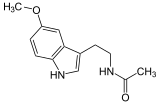Simplified molecular input line entry specification facts for kids
The Simplified Molecular Input Line Entry Specification, or SMILES, is a special way to write down the chemical structure of molecules using a short series of computer characters. Think of it like a secret code for molecules! Most computer programs that help you draw molecules can take a SMILES code and turn it into a 2D picture or even a 3D model of the molecule.
Arthur Weininger and David Weininger created the first SMILES code system in the late 1980s. Other groups, like Daylight Chemical Information Systems Inc., have since updated and added to it. In 2007, a group of open-source chemistry experts called Blue Obelisk made their own open standard called "OpenSMILES."
In 2006, a big chemistry organization called IUPAC introduced a different standard called InChI. Many people find SMILES easier to understand than InChI. Also, lots of different software programs work with SMILES, which makes it very useful for chemists.
What is SMILES?
SMILES uses simple letters and symbols to represent atoms and how they are connected. For example, 'C' means carbon, 'O' means oxygen, and '=' means a double bond between atoms. It's like writing a sentence that describes a molecule's shape!
How SMILES Works
SMILES codes can be turned back into 2D pictures of molecules using special computer programs. Sometimes, a SMILES code might lead to a few slightly different 2D pictures.
When converting SMILES to 3D models, computers need to figure out the best way atoms are arranged in space. SMILES only tells the computer which atoms are connected, not the exact angles. So, programs use methods to find the most stable 3D shape for the molecule. There are many free tools online and to download that can do these conversions.
SMILES Examples for Molecules
Here are some examples of how different molecules look when written in SMILES code:
| Molecule | Structure | SMILES Formula |
|---|---|---|
| Dinitrogen | N≡N | N#N |
| Methyl isocyanate (MIC) | CH3–N=C=O | CN=C=O |
| Copper(II) sulfate | Cu2+ SO42- | [Cu+2].[O-]S(=O)(=O)[O-] |
| Œnanthotoxin (C17H22O2) |  |
CCC[C@@H](O)CC\C=C\C=C\C#CC#C\C=C\CO |
| Pyrethrin II (C22H28O5) |  |
COC(=O)C(\C)=C\C1C(C)(C)[C@H]1C(=O)O[C@@H]2C(C)=C(C(=O)C2)CC=CC=C |
| Aflatoxin B1 (C17H12O6) |  |
O1C=C[C@H]([C@H]1O2)c3c2cc(OC)c4c3OC(=O)C5=C4CCC(=O)5 |
| Glucose (glucopyranose) (C6H12O6) |  |
OC[C@@H](O1)[C@@H](O)[C@H](O)[C@@H](O)[C@@H](O)1 |
| Bergenin (cuscutin) (a resin) (C14H16O9) |  |
OC[C@@H](O1)[C@@H](O)[C@H](O)[C@@H]2[C@@H]1c3c(O)c(OC)c(O)cc3C(=O)O2 |
| A pheromone of the Californian scale insect |  |
CC(=O)OCCC(/C)=C\C[C@H](C(C)=C)CCC=C |
| 2S,5R-Chalcogran: a pheromone of the bark beetle Pityogenes chalcographus | ![(2S,5R)-2-ethyl-1,6-dioxaspiro[4.4]nonane](/images/thumb/8/8e/2S%2C5R-chalcogran-skeletal.svg/130px-2S%2C5R-chalcogran-skeletal.svg.png) |
CC[C@H](O1)CC[C@@]12CCCO2 |
| Vanillin |  |
O=Cc1ccc(O)c(OC)c1 |
| Melatonin (C13H16N2O2) |  |
CC(=O)NCCC1=CNc2c1cc(OC)cc2 |
| Flavopereirin (C17H15N2) |  |
CCc(c1)ccc2[n+]1ccc3c2Nc4c3cccc4 |
| Nicotine (C10H14N2) |  |
CN1CCC[C@H]1c2cccnc2 |
| Alpha-thujone (C10H16O) |  |
CC(C)[C@@]12C[C@@H]1[C@@H](C)C(=O)C2 |
| Thiamin (C12H17N4OS+) (vitamine B1) |
 |
OCCc1c(C)[n+](=cs1)Cc2cnc(C)nc(N)2 |
See also
 In Spanish: SMILES para niños
In Spanish: SMILES para niños

